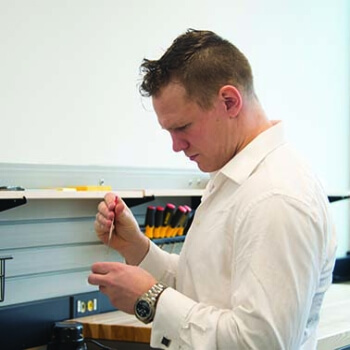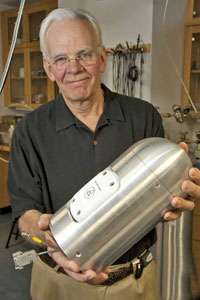News
Jay Munster working on his mask prototype at the i-Lab. (Photo by Molly Aiken.)
This story has been reposted from the Graduate School of Arts and Sciences Bulletin
While visiting Beijing in 2008, Jason Munster went for his customary morning run but started to feel sick soon after. “I was in good shape, but the air pollution was so bad that I got laid low entirely,” he explains.
After Munster, now a Ph.D. candidate in engineering sciences at the Harvard John A. Paulson School of Engineering and Applied Sciences, wrote about the experience on his energy and the environment blog, he received numerous responses from readers asking how they could avoid getting sick as he had. “They asked me, ‘What can I wear when I exercise?’” Munster recalls. He realized that their options, like his, were limited. “You can buy a 3M mask, and it will filter out the particulate matter in the air, but it can’t filter out all the other things that kill you,” Munster explains with a wry smile. 3M masks, he adds, are designed for medical and industrial settings, and factors such as cost make them impractical for everyday personal use, especially in developing nations where people need them most.
Munster’s friends urged him to create something that could filter out both particulate matter and air pollution. “I kept saying, ‘No, that’s not my field,’” he recalls. A few years later, though, he realized he was in fact ideally positioned to address this problem. Based in the lab of James G. Anderson, Philip S. Weld Professor of Atmospheric Chemistry, Munster builds instruments to measure methane and carbon dioxide levels, particularly pressing factors as the melting Arctic permafrost uncovers 300,000 years’ worth of decomposing plant matter. As Munster puts it, “Knowing how to build scientific instruments, plus being seated in a chemistry department as an engineer, gave me the skills necessary to invent an affordable way for individuals to protect themselves from air pollution.” Thus, in 2014, the idea for the company now known as Blue Skies was born.
Read the rest of the article in the GSAS Bulletin.
Cutting-edge science delivered direct to your inbox.
Join the Harvard SEAS mailing list.
Scientist Profiles
James G. Anderson
Philip S. Weld Professor of Atmospheric Chemistry
Press Contact
Adam Zewe | 617-496-5878 | azewe@seas.harvard.edu

